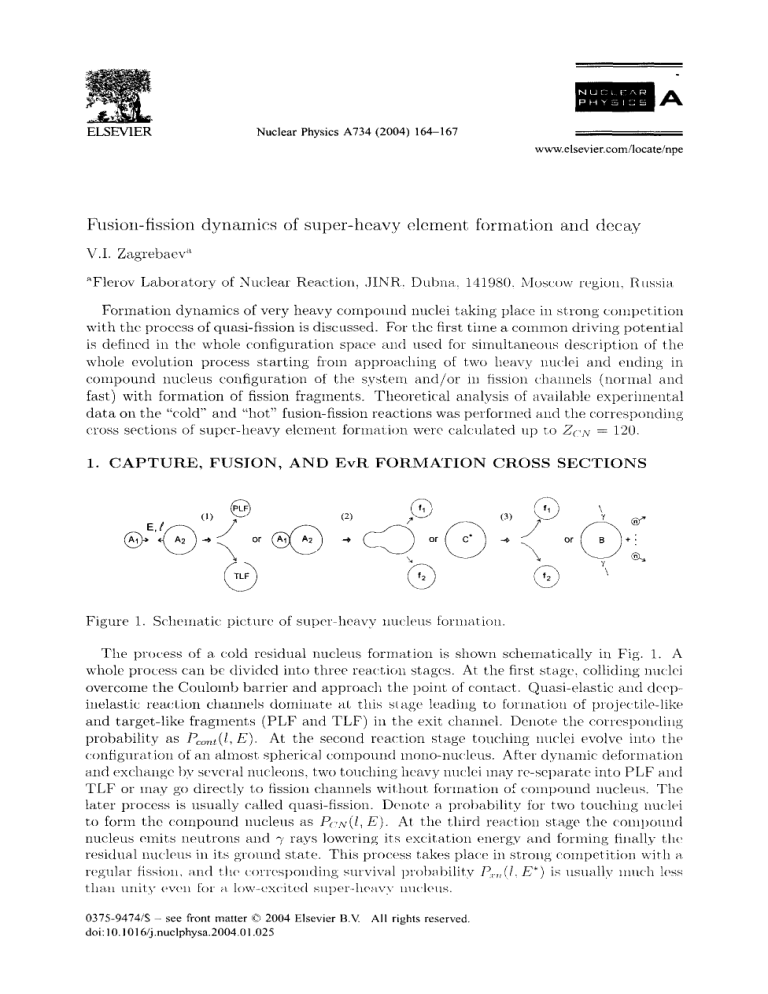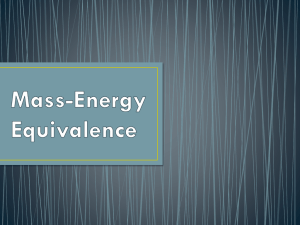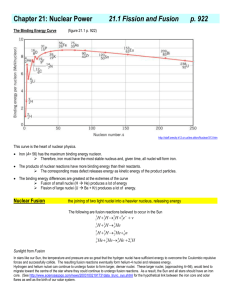
ELSEVlER
Nuclear
Physics
A734 (2004)
164-167
www.elsevier.comllocatelnpe
Fusion-fission
dynamics
of super-heavy
clement
format,ion
and
decay
V.I. Zagrebacv”
aFl~r~~
Laboratory
of Nuclear
Reaction.
.JINR. Dubna.
141980.
Mosc~ow region.
Rllssia
Format,ion dynamics of very heavy cornpo~md nuclei taking place ill strong compet,ition
with the process of quasi-fission
is discmsrd.
For the first time a common driving potential
is defined in the whole confignrat,ion
space and IWY~ for simultxneo~~s description
of the
whole evolut,ion process starting
from approa&iii,
0 of t,w;o heavy nuclei and ending in
compound
nucleus configuration
of the system and/or ill fission (~ha1111cls (norlnal and
fast) with formation
of fission fragments.
Theoretical
analysis of available experimental
data on the “cold” and “hot” fusion-fission
reactions wa.s performed and the corresponding
cross sections of super-heavy
element formal ion were calculated up t,o ZcV,V = 120.
1. CAPTURE,
FUSION,
AND
EvR
FORMATION
CROSS
SECTIONS
4
Figure
1. Schematic
pictllrc
of super-heavy
r~uc~lc~~s
fomlation
The process of a cold residual n~~lcus
formation
is showrl scllematically
in Fig. 1. A
whole proct~ss can bc divided iuto three react,im st,agcis. At the first stagcx. colliding mc,lci
overcome the Coulomb barrier and appm~cli t,lie l)oiut of contact. Quasi-elastic
and clcc~p
inelastic react,ion channels dominate
at this stagcl leading to format ion of projrc,tilc-like
and target-like
fragments (PLF and TLF) ill the exit channel. Dcnot,e the corrc~spontli~lg
probability
as Pcont(l, E). At the secoud rcartion
stage touchin, 0 mclci evolve iiit,o the
umfigurat iou of an almost, spherical compourltl I~OIIO-IIU(.~CUS. Aft,er dynamic defornlwtion
and cxhangc
1)~ scvc1~1
mclrolls.
two t,ouching htavy nuc,l(G may rc-scparat,c into PLF and
TLF or may go directly t,o fission channels wit.hout, fcmrlatiou of c~omponnd ~nlclr~.
The
later process is usually called quasi-fission.
Dmotc R probability
for two touching uuc~lri
to form t,lic coinpouiid
iiiicleus as P(-,vjl, E). 4t the t,hird rractioii
stage t,lic coiiilmuitl
nucleus
emits neutrons and A, rays lowcring its cxcit~atioii ~mxgy and forining fiimlly t,hcs
residual ~luclr~ in its gromd state. This prou~ss t,akrs plac,c, ill stroll, (1 colllpct itioil with il
regular fissioil. and tllc, c~mxspoiiclin g survival pmbahility
r,,,(/. E’) 15
‘: llSll~l11V 1r1wl1 lws
tll?\ll uiiity (‘W’ll fOL il lowcxc,itetl
SlliIf’l.-llPil\.!.
Illl(~l(~llS.
0375-9474/S
- see front matter
doi: 10.1016/j.nuclphysa.2004.01.025
Q 2004 Elsevier
B.V.
All rights reserved
VI. ZagrebaevlNuclear
Ph~eics
A734
(2004)
164-167
The formation
cross section of a cold residual nucleus B, which is the product
evaporation
and 7 emission from an excited compound
nuc~leus Cr? formed in
process of two heavy nuclei Al + A2 + C + B + m + Ny at c’.m. energy
the Coulomb barrier in the entrance channel, can be drcomposcd
ov(‘r partial
written as
G?;‘a
r;~~(21+1:i:,,,ji,~).~~!~iAi+l2iC:EI),r,,;:Ci~;~*.i).
165
of neutron
the fusion
E close to
waves and
(1)
Semi-empirical
[l] and/or channel coupling approaches [x.3] may be used t,o calculatr
rather accurat,ely a penetrability
of the mult,i-dilncnsional
Coulomb barrier Prolif (1. E) and
the corresponding
capture cross section. The survival probability
P,,,(1, E*) of an excited
compound
nucleus can be also calculated
rather accurat,ely within a statist,ical model
[4,1]. The most uncertain
parameter
here is the height of the fission barrier.
Unfortunately, the fission barriers of super-heavy
nuclei calculated within the different approaches
differ greatly (by several MeV). However, cxperimrntal
estimation of these barriers is st,ill
possible [5] The processes of the compound
nucleus formation
and quasi-fission
are the
least studied stages of heavy ion fusion reaction. Toda.y t,here is no consensus for the mecllanism of the compound
nucleus formation
itself. and quite different, sometimes opposite,
in their physics sense, models are used for its description.
2. TWO-CORE
MODEL
In [6,7] a new approach was proposed for description
of fusioll-fission
dynamics based
on a sem-empirical
version of the two-center
shell model idea [8]. It is assumrxd t,hat,
on a path from the initial configuration
of two touchin g nuclei to the compound
nucleus
configuration
and on a reverse path to the fission channels the nuclear system consists of
two cores (Z,, N,) and (22, N2) surrounded
with a certain number of common (shared)
nucleons AA = Ac.v - A1 -AZ moving in the whole volume occupit,d by the t,wo cores. The
processes of compound
nucleus formation:
fission and quasi-fission take p1a.c~ iu the space
(Z,, IV1 ( &; 2,. N2,6,), where d1 and 62 are the dynamic dtformat,ions
of the cores. The
compound
nucleus is finally formed when the elongation
of tllr> system bec,orncs shortrl
than a saddle point elongation
of CN.
Within
this two-core
model
the corresponding
fusion-fission
driving
pot,cntial
I$,,_,,,(R,
Z1: ,YI, b, ; 22: Iv,, 6,) was derived and was found to be close to the two-center
there are several advantages
shell model potential
energy at R < Rcont [6]. Nevertheless,
of the proposed approach. The driving potential is derived basing on experimental
binding
energies of two cores: which means that the (‘true” shell structure is taken into w.crount
and. thus; for well separated nuclei (large values of R) l’f?Ls-~zs gives an ez&it
values
of nucleus-nucleus
interaction.
For the first time the fusion-fission
driving potcWia1 is
defined in the whole region Rc.,l; < R < xx. it is a continuous
function at R = Rro,,, it
gives the realistic Coulomb barrier at R = X,1 > R,,,LL and may bc used for simultanr~olls
description
of the whole fusion-fission
process. At last,, along with using the variables
(Z,, Nl; Z,, Nz), one may easily recalculate
the driving potential
as a function of mass
asymmetry
(Al - A2)/(A1 + AZ) and elongation
RI2 = r,o(At’3 + A:‘“) (at R > R,.,,,,,
RI2 = R = s + RI + Rz, where s is the distance between nuc1ea.r surfaces).
These variables
along with deformations
bl and 62 are commonly used for &script ion of fission process.
f!I. Zagrebaev
iNuclear
Physics
A 734 (2004)
164-I
67
R12 (fm)
Figure 2. Driving potential
Vru,9-fts
o f t,lie nxlewr
system consisting of 116 protons and
180 neutrons.
(a) Potential
euergy of two touching nuclei at A, + i12 = Ac,v, a.4 = 0.
i.e., along the diagonal of the lower figure, which correspouds
to the black solid (‘IXVE on
the right-bottom
panel. Topographical
landscape of the driving potential
on the plane
(Z, - Z,) (h) and on the (mass asymmctr>- - elongation)
plane (d). The dark regions
correspond
to the lower potential
energies.
The dashed, solid, and dotted curves w-it11
arrows show fusion, quasi-fission,
and regular fission paths, rcspectivcly.
(c) Three h~m~prtl
fission harrier calculated along the fission path (dotted WWE).
As can he seen from Fig. 2, the shell structure. clearly revealing itself in the contact of
two nuclei, is also retained at, R < RcoTtt(see the deep minima in thr regions of Z,,.’ - 50
the fssiou path (dotted curves in Fig. 2h,tl) the
and 21,~ - 82 in Fig. 2h). Following
system overcomes the multi-humped
fission harrier (Fig. 2~). Thr intermediate
minima
correspond to the shape isomer states. From analysis of the driving potential (SW Fig. 2h)
we may definitely
conclude now that these isomeric states are nothing else but two-clustrbl
configurations
with magic~ or semi-magic ores.
Using the driving potential VfuspfLs one may determine the probability
of the compound
nucleus formation
P c,v. It can he done, for example, by solving t,lIc> master equation for
the distribution
function F(Z1, Nj) .Zz>IV,, 6,. &: t) [6.7]. The probability
of the compo~u~tl
nucleus formation
is defined as an integral of the distrihut,ion
function over the, region
Similarly
one can define the prohahilities
of findiug t,hc system in difbrcnt,
R < &xidle.
quasi-fission
channels. i.e., the charge aud mass distriblltions
of tllc fission fragmc,ut,s.
cil. Zagrebaeu /Nuclear Physics A 734 (2004) 164-l 67
3. CROSS SECTIONS
167
OF SHE FORMATION
Calculated
in that way the capture, fusion, and SHE format,ion cross sections for t,he
“cold” and “hot” fusion reactions leading to EvRs with 2 > 102 can be found in [9]. In
Fig. 3 the calculated excitation functions for product,ion of supcl,-heavy nuclei in reactions
induced by “‘Ca are shown for 2nt5n channels. In the calculations
the shell corrections to
the ground state energies of super-heavy
nuclei proposed by P. hItiller et (~1. [lOI wrre used
to estimate the corresponding
fission barriers.
From obtained results one may conclude
that the “hot” fusion reactions can be successfully used at existing facilities for a synthesis
of super-heavy
ml&i with Z up t,o 120. The prefcrablc beam rnergj- corresponds
to about
40 MeV of CN excitat>ion energy with detection of 3n and/or 411 evaporation
products.
i.e. it should bc slightly higher than tliosc used in the previous cxprriments
[ll].
Figure 3. Calculated
excitat,ion functions of super-heavy
element formation
in the fusion
reactions induced by “%a. Thin curves correspond to lighter isotopes (lower energy scale).
REFERENCES
1.
V.I. Zagrebaev, Y. Aritomo,
M.G. Itkis, Yu.Ts. Oganessian, and M. Ohta, Phys.Rev.
C 65 (2002) 014607.
2. K. Hagino, N. Rowley, A.T. Kruppa, Comp. Phys. Commun.:
123 (1999) 143.
3. V.I. Zagrebaev and V.V. Samarin, JINR report No. P7-2003-32,
Dubna, 2003:
CC fusion code of the NRV: http://nrv.jinr.ru/nrv.
4. A.V. Ignatyuk,
Statistrcal
propertzes
of exczted atornac
nuclei,
Energoatomizdat.
Moscow, 1983.
5. M.G. Itkis, YL~.Ts. Oganessian, and V.I. Zagrebaev, Phys.Rcv. C 65, 044602 (2002).
6. V.I. Zagrebaev, Phys.Rev. C 64 (2001) 034606.
7. V.I. Zagrebaev, J.Nucl.Radiochem.Sci.
3. No. 1 (2002) 13.
8. U. hlosel, J. Maruhn,
and W. Greiner, Phys.Lett,. B 34 (1971) 587; J. Maruhn
and
W. Greiner, Z.Physik, 251 (1972) 431.
9. V.I. Zagrebaev. N.G. Itkis, and Yu.Ts. Oganessian, Yad. Fiz., 66. No.6 (2003) 1069
[Phys. At. Nucl.: 66, No.6 (2003) 10331.
10. P. Miiller, J.R. Nix, W.D. Myers. W.J. Swiatecki. At.Data n’ucl.Dwta Tables 59 (1995)
185.
11. Yu.Ts. Oganessian et al., Phys.Rev. C 62 (2000) 041604(R):
F’hys.Rcv. C 63 (2001)
011301(R).








